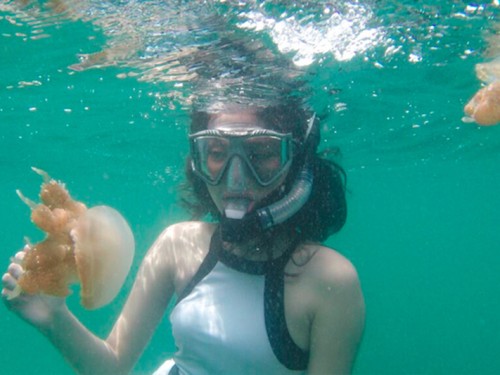
Kakaban Island: Come Swim among Stingless Jellyfish
Indonesia is a fascinating country in every
sense of the word. Rich in culture, natural beauty and biodiversity. Home to the weird, the wacky and the wonderful. And just when you think you've seen and done it all, think again, for there is still a lot coming.
For a really exceptional sensation, how about swimming with jellyfish? Yes, you heardit right, jellyfish, the one sea creature that is most likely to give you stings, itches, and all kinds of unpleasant swimming experiences. Well, at Kakaban Island in East Kalimantan, you can , not only swim unharmed with this fascinating creature, but you can actually touch them since the island is one of only two places on earth where you can find stingless jellyfish.

Kakaban Island is a large coral atoll in the Derawan Archipelago in the Regency of Berau, off the east coast of East Kalimantan Province, covering 774 hectares of uninhabited terrain. Its most distinctive feature is a huge land-locked lake, which makes up almost two thirds of the island. This brackish lake is alive with several species of endemic marine life, including millions of stingless jellyfish that only exist in one other place on the planet which is at Palau in Micronesia. The island is shrouded among a tangle of dense mangrove forests, right down to where the water meets the earth. There are very few sections of beach, as most of Kakaban's circumference end in a rocky wall of sheer limestone cliffs, some sections dropping hundreds of feet to the choppy waves below.

Kakaban Island is one of 31 islands belonging to the Derawan archipelago, which include Sangalaki, Maratua and Derawan Kakaban was elevated through years of geological pressure, which eventually sealed off what was once a lagoon, creating the Kakaban Lake. "Kakaban" comes from a word in the local dialect meaning "hug," because of the way the 9-shaped island "hugs" the lake in the center. Kakaban Lake has been declared a government nature reserve, and has been nominated as a World Heritage Zone.

The ecosystem of the lake is very similar to that of the open sea, but with a twist! The trapped sea-water diluted with rain water and ground water creates a unique habitat that has caused the creatures trapped inside to evolve! The lake has warm, brackish water of 11 to 17 meters in depth, and is carpeted in marine green algae. Four species of jellyfish crisscross the waters of Kakaban Lake, but unlike their counterparts beyond the coral wall, the lake-jellies have no natural predators, resulting in the evolution of the species to no longer need their venom as self-defense.

Other evolutionary processes have also taken place in this lake: The box jellyfish, normally one of the deadliest creatures in the world, in addition to losing its sting, it has shrunk to barely a third its normal size. The Spotted Jellyfish is no longer spotted, and the Cassiopeia swims upside down, with its tentacles to the surface. This is so the sun may shine on its algae-covered tentacles, creating a photosynthetic reaction and thereby producing food! Meanwhile, the white anemone has evolved into a passive jellyfish predator. Eight species of fish also dwell in this biological paradise, as well as sea cucumbers, sponges, crabs, snakes, and orange purple and yellow clams.

Marine scientists and geologists have long puzzled over the phenomena of the survival of plant and animal life in so isolated an environment, but as eloquently stated in the Jurassic Park Movie: "Life finds a way", and Kakaban Island is the perfect proof of that. "Jellyfish Lake," on Palau Island in Micronesia, is the only similar environment on Earth, housing two species of stingless jellyfish. Thus making Kakaban Lake not only the largest, but also the most diverse brackish lake in the world.
To Get There:
The recently expanded Kalimarau Airport in the town of Tanjung Redeb, in the Berau Regency now receives more flights including international flights. The airport sits at an elevation of 59 feet (18 m) above sea level. It has one runway designated 01/19 with an asphalt surface measuring 1,850 by 30 meters. The airport has 10,462 square meter domestic terminal, a 505 square meters VIP terminal, a 5,700 square meters international terminal, and 592 square meters cargo terminal.
Currently there are 4 airlines that serve flights to Berau: Garuda Indonesia, Wings Air, Sriwijaya Air, and Kalstar Aviation, connecting the regency with Balikpapan, Jakarta, Surabaya, Samarinda (East Kalimantan) and Tarakan , Malinau, and Nunukan in North Kalimantan. From Kota Kinabalu and Tawau in Malaysia, there are flights to Tarakan which connects with the flight to Berau.
Once in Berau you can hire a speedboat for the 2 hour ride to the Derawan islands. Speed boats generally have a seating capacity of 15 people, and can be rented to take you to several of the Derawan islands in one day. Boats can be chartered direct to Kakaban, but as there are no accommodations there, the usual routes go through its neighboring islands of Sangalaki, Maratua or Derawan. Kakaban is about 20 minutes from Sangalaki, 30 minutes from Maratua and 45 minutes from Derawan.
Now, Susi Air also serves Tanjung Redep-Maratua-Tarakan vice versa, however, the flight is only once a week and it is a relatively small aircraft for 9 passengers





No comments:
Post a Comment